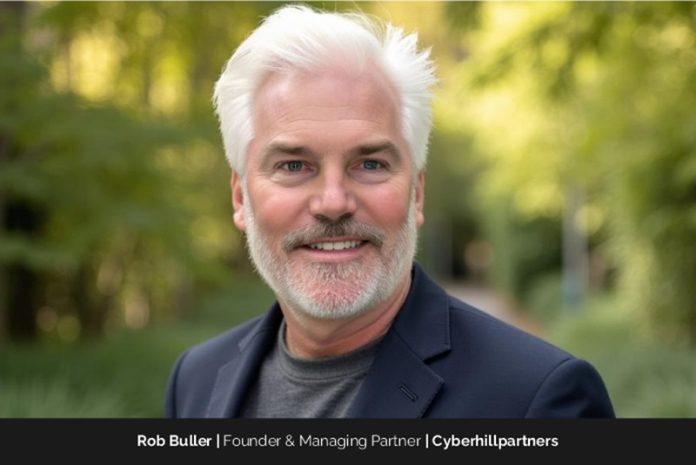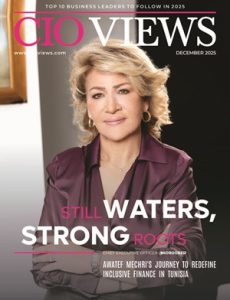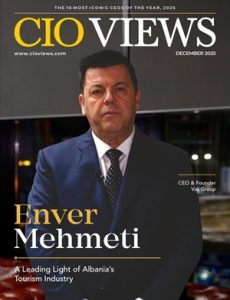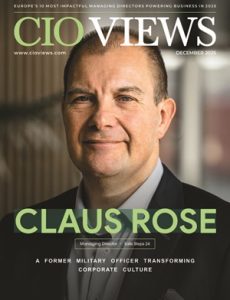Driving Innovation. Elevating Teams. Making a Difference.
Rob Buller, Founder and Managing Partner of Cyberhill Partners, is a visionary technologist and serial entrepreneur known for redefining how enterprises approach cybersecurity, AI, and cloud transformation. Whether driving client outcomes or launching disruptive ventures, he has built a career on translating complex technology into meaningful business impact. This dedication has solidified his position as a pioneer and influential icon in the rapidly evolving, hyper-competitive technology industry.
Cyberhill is far from Rob’s first venture. Over the past two decades, he has founded multiple companies, including Pahu—the world’s first AI-based Identity (patent pending). His entrepreneurial journey began with an online grocery shopping platform. In the late 1990s, while Amazon was gaining traction by selling books online, Rob introduced an innovative model for online grocery ordering with in-store pickup—years ahead of major retailers like Walmart and Target. He was one of the earliest to envision the now-standard “buy online, pick up in store” experience, anticipating a transformation in consumer behavior.
What continues to drive him is helping customers solve complex problems. “That’s the greatest thing,” he says. “It’s why I’m in this business.”
Choosing Tech Over Wall Street
When Rob graduated from school, he interviewed with both Goldman Sachs on Wall Street and Price Waterhouse. Following these interviews, he was presented with two career choices: either pursue finance in New York or join Price Waterhouse and dive into technology.
“I thought to myself that technology is going to grow into something big,” Rob recalls. “I wanted to be a part of this kind of growth. That is really what started my career in technology.” He entered an intensive MITIS program, where he was trained in programming and systems thinking.
In programming, Rob explains, one must be very specific and instruct the program regarding every piece and part to properly build something. “This requires a different kind of thinking,” he adds. “And I loved it.”
While Rob remains passionate about emerging technologies, he’s quick to point out that many trends aren’t entirely new. “It often feels like we’re watching the same movie play out in new formats,” he says—referring to the recurring cycles of hype, adoption, and reinvention that define the tech world.
Founding Cyberhill: Securing the Future of Enterprise
Rob, a pioneer in e-commerce, AI, and cybersecurity, has a penchant for building solutions for people. He is driven by his vision to improve people’s lives. Rob founded Cyberhill in 2017, a time when cloud computing was booming and cybersecurity was becoming a significant concern for companies. “It was a ripe opportunity to help companies,” he says.
“Our view from the very beginning was that as enterprises expand to the fringes with IoT, they need to be smarter, more secure, and scalable,” Rob explains. “So scalable is cloud, smarter is AI, and more secure is cybersecurity. These are Cyberhill’s three main areas of focus.”
Living just outside Washington, D.C., at the time, Rob was immersed in discussions about regulations and policy-making. These conversations inspired the founding of Cyberhill, a name drawn from Capitol Hill, symbolizing the intersection of governance and digital security. Rob envisions Cyberhill as a bridge that elevates the importance of cybersecurity by emphasizing compliance and regulatory alignment.
Inside Cyberhill: What Sets It Apart
Cyberhill is a professional services firm specializing in engineering future-state software solutions for the Fortune 500 and U.S. Government. With expertise in cybersecurity, cloud computing, data analytics, and AI, the company delivers comprehensive implementation services that drive success and security. Rob and his team engage with leaders involved in technology strategies and operations throughout a business, such as CIOs, CISOs, CTOs, and Chief Artificial Intelligence Officers. They help these leaders prevent issues related to corporate data and cybersecurity—issues that could land a company on the front page of the Wall Street Journal. “We help them solve these issues, and we’ve been very successful in that,” Rob says.
In addition to Fortune 500 clients, Cyberhill has also assisted large, multi-billion-dollar multinational companies. According to Rob, they have had clients with extremely complex environments, including 200 domains and data centers in Singapore and the Netherlands, utilizing both AWS and on-premise systems in New York and San Diego as examples. These enterprises operate on a massive scale, managing enormous volumes of data across global infrastructures. Rob explains that because their network is expansive, cybersecurity threats are prevalent, and data consumption is necessary throughout their companies. CIOs lead cost centers in their organizations; therefore, their capabilities are limited. “So, we come in and help for a period of time and solve the problem,” Rob says.
“One of the things that sets Cyberhill apart is that we bring an entire team to every engagement,” Rob explains. “We don’t just solve the problem—we empower our clients.” After implementation, Cyberhill provides comprehensive resources like webinars and training documents to ensure teams are set up for long-term success. “Our goal is to teach people to fish, not just hand them a fish,” he adds, emphasizing their commitment to knowledge transfer and sustainable impact.
Cyberhill has experienced steady growth since its founding, and according to Rob, every year has been a growth year. “Now, with what we are doing, things are starting to take off,” he says. “And we are still evolving.”
Legacy in Motion: Building Teams, Shaping Leaders
Rob has several achievements to his credit. According to him, his greatest achievement is offering people the opportunity to excel. “It’s about what we build and what we leave behind,” he adds, emphasizing long-term impact.
When Rob was a partner at KPMG, he met Steve Temares, then CFO and acting CEO of Bed Bath & Beyond. Steve told him that they needed an e-commerce site. “So, we built an incredible Bed Bath & Beyond e-commerce site, and we pioneered order online, pick up at the store,” Rob recalls. “We also launched one of the first online wedding registries, which had never existed before.” All these elements became a $3 billion to $4 billion a year revenue generator for Bed Bath & Beyond.
Rob says it’s incredibly rewarding to see former colleagues—whether from the e-commerce build or his many startups—go on to grow, succeed, and pursue new opportunities. “It’s fulfilling on every level,” he says.
Across every venture, Rob has been intentional about building high-performing teams and fostering a culture where people thrive. Many believe it is a “privilege” to work at his company. Rob remembers that when they were handing out stock options at a company he started, one person said, “I don’t need equity. It is just an honor to work here, and I love being with all these people.” This moment has stuck with him.
The Coach’s Mindset
As Managing Partner, Rob sees himself as a coach—guiding a team of high performers, encouraging them to be more disciplined, identifying areas they need to improve, and preparing them for the challenges ahead. “I’m a tremendous asset to the company in that role,” he says. “These days, I spend more time working on the business than in the business.”
Over the course of his career, Rob has gained deep experience and insight, which he openly shares with his team. His ability to envision the company’s future allows him to coach with both strategic clarity and practical support. While he also oversees Cyberhill’s financial and legal operations, he finds greater fulfillment in mentoring and leadership.
Rob and his team are energized by their current projects and what lies ahead. “We’re working on incredible initiatives, partnering with exciting clients, and having meaningful conversations about future opportunities,” he says. That momentum keeps the team motivated and inspired.
To Rob, great leadership is a balance of vision and service—setting the direction while equipping the team with the tools, resources, and support they need to succeed.
What’s Next for Cyberhill: Growth with Purpose
“The way forward is more clients, more partners, more people,” Rob says. He wants to see Cyberhill follow the natural evolution of a business – growing in size, increasing revenue, and developing alongside clients and partners. Rob and his team are considering expanding their footprint globally through mergers or acquisitions, especially in Europe; however, their current focus is on growth within the U.S. “There is a thought to expand internationally, but not this year. Maybe next year,” he says. They already have a few clients in Canada.
Rob points out that their core values remain the same: “executing effectively for all our clients” and “doing right by our people.” As Managing Director, he intends to continue ensuring that everyone is taken care of, that everyone is learning and growing, and that they have a work-life balance.
Disruption at the Edge: How Emerging Tech Reshapes Markets
The introduction of a new technology can change the entire industry, says Rob. AI is an example of that. According to him, more disruption is likely with quantum computing on the horizon and the invention of new technologies.
“When new technologies come into play, they spawn new industries, new technologies, software, and hardware that complement software,” Rob explains. As the shift occurs, if older companies do not keep pace with the changes in the industry, they will fall behind, he adds. Currently, Arista Networks, an AI network company, is “blowing the doors off” Cisco because they use infused AI. Cisco may become obsolete if it does not adapt and innovate.
Rob notes that every new wave of technology tends to generate a lot of hype, prompting widespread adoption. This rapid uptake often fuels exponential growth—until the inevitable decline begins. “If companies don’t have the next innovation ready to propel them forward, they risk fading out,” he explains. “That’s why it’s critical to stay ahead of emerging technologies—and that requires consistent investment.”
Rob challenges the outdated notion of technology as a cost center, arguing instead that it is the core engine of modern business.
Take the example of Google and Amazon – they are on the web, and everyone interacts with the front end of their business. “That’s their storefront, and they’re worth trillions of dollars,” Rob points out. If a company does not have the technology infrastructure to keep up with growing business or if they are not joined at the hip, then it will fall behind, he adds. Google and Amazon, on the other hand, are not going to fall behind because their entire business is integrated into technology.
“I think a lot of CEOs or boards look at technology as a cost center and that is all it is,” Rob says. “We need to think differently about technology at the C-level and board level; it is part of the business.”
JP Morgan recently announced that it is using AI and quantum technologies across multiple divisions within the bank. “That’s exactly the kind of alignment we need more of—technology driving business outcomes,” Rob says. “It should be the pairing of technology and business together to grow.”
The AI Horizon: What Comes After Generative?
Rob notes that they have transitioned from second-generation AI to generative AI. He also points out that Web3 is beginning to emerge with ontologies and knowledge graphs—concepts that arise from various pieces of data.
AI continues to evolve, and Rob sees its trajectory paralleling the human brain’s adaptability—with vast, still-untapped potential. He believes that AI will likely take on various forms. “Maybe in the future, it will be quantum AI or Q of AI or something along those lines,” he adds. Rob does not think AI has reached its peak at this point. “I think certain pieces of AI might follow a bell curve,” he says. “And it will be replaced with newer advancements, such as quantum AI or other emerging technologies.”
“And I think AI as a concept will probably continue to evolve over the next 10 or 20 years,” he adds.
A Legacy of Learning and Leadership
Rob wants to leave behind a legacy of people who learned from him. When he was advancing in his career, he had mentors who guided him and offered him “nuggets of wisdom” that he now lives by and shares with people he works with.
“My goal is to pass on what I’ve learned—so others can think critically, lead confidently, and build even better.”
Message to Aspiring Leaders
Exemplary leaders don’t just set the vision—they roll up their sleeves and work alongside their teams to achieve it, Rob tells aspiring leaders. He points to the late Apple founder Steve Jobs, who was known for spending time on the factory floor, collaborating with designers, engineers, and other team members. “He didn’t just deliver a vision; he engaged with people and supported them,” Rob says.
His advice to future leaders: be part of the team. Build alongside your engineers, don’t just lead from above. “Do both: direct the vision and pay attention to your team,” he adds.
Still Climbing the Hill
Despite all his accomplishments, Rob measures success not just by milestones, but by the people he empowers and the ideas he leaves behind. “I’m never satisfied,” he says. “There’s always more to build, more to teach, and more ways to make a difference.”





